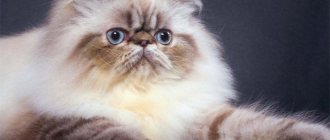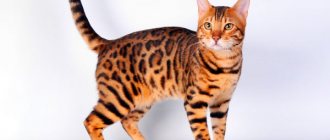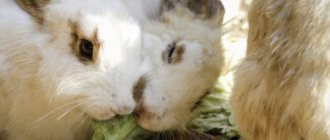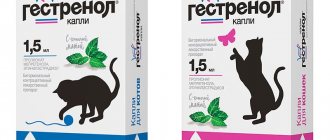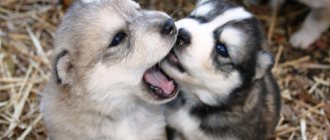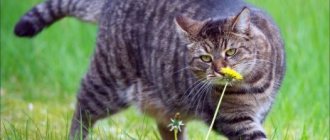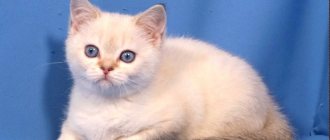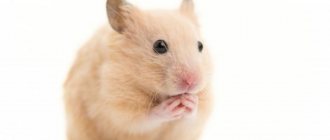A balanced diet is a guarantee of the full development and health of your pet. Not every cat owner has the opportunity to create the right diet, calculate the right ingredients and cook every day.
Moreover, it is not advisable to give treats from your table, since human food contains a lot of seasonings, salt and other components that are harmful to the animal. Therefore, it is worth listening to the advice of veterinarians on what food is best to feed your cat.
Features of feeding kittens
A kitten's diet is radically different from that of adults. He needs the whole complex of vitamins and microelements. As it grows, all vital organs and systems are formed, and a lack of the necessary components will negatively affect health.
A kitten's diet is radically different from that of adults.
For up to 2 weeks, it is recommended to take purely breast milk substitutes, which are sold in pet stores. If they are not available, you can prepare the mixture yourself by combining 4 parts goat or cow milk with 1 part egg white.
As you grow, this nutrition will not be enough. In the 3rd week you need to introduce additional ingredients into the diet. As a supplement, you need to use canned food and dry mixtures for kittens of the premium and super-premium categories.
Meals should be chosen depending on age; this information should be checked with the seller or found on the packaging. It is recommended to combine them with dairy nutrition: 30% is feed, 70% is dairy nutrition.
Advice! You should not purchase cheap products, as they provoke the development of diseases.
Age when you can switch to regular food
It is recommended to completely switch to regular food for the younger age category at 1 month. Formula milk should also continue to be given, but in a smaller dosage. And by 2 months the kitten should be switched to the main type of food. This transition will help avoid stress for your pet.
It is worth changing the product line only as a last resort.
Energy needs of a cat
The life of a cat is a continuous expenditure of energy, which is needed for the functioning of all organs. The body receives it as a result of oxidation (“burning”) of fats, proteins and carbohydrates that make up food. Only part of this energy is absorbed and participates in metabolism.
A cat's energy needs are determined by the amount of food they eat.
An animal's energy expenditure depends on weight, age, weather conditions, physical activity and other circumstances. Calorie needs decrease with age, in hot weather, and also during periods of least activity.
The animal's energy needs are determined by the amount of food eaten daily. Calories are often not listed on packages. They are replaced by data on the daily nutritional intake, taking into account the weight and condition of the animal.
Cats need basic elements:
- protein;
- taurine;
- fats (linoleic and arachidonic acids);
- carbohydrates (“dietary fiber”);
- minerals, macro-/microelements (calcium and phosphorus);
- vitamins A, D, K and E.
Food selection for an adult
When choosing natural food, the cat owner should focus on the needs of the animal.
There are 2 food options for an adult pet: ready-made dry/wet ingredients and natural food. Which one to choose, everyone decides for themselves, depending on personal preferences.
But veterinarians advise purchasing finished products that contain all the necessary substances in an accessible form. At the same time, you can diversify your diet with both dry mixture and wet food. The main thing is to choose premium and super-premium products.
You can judge the beneficial properties of a particular product by the condition of the coat (smooth, shiny) and the activity of the animal.
When choosing natural food, the cat owner should focus on the needs of the animal, depending on its age and breed.
Also keep in mind that the diet should include not only meat, but also cereals, vegetable oils, dairy products, vegetables, fish, and eggs.
Be sure to read:
Is it possible to feed a cat dry food and natural food at the same time: pros and cons, which is better?
Choosing cat food based on ingredients
Check the feed for the quantity and quality of animal proteins
Cats are obligate carnivores, so they need meat protein to thrive. Check the ingredient list of your cat food to make sure the first ingredient is meat, such as chicken, tuna, beef or turkey. Good cat foods have specific meat at the top of the ingredient list, not “meat by-products (offal)” or “poultry.”
- If the label simply states “meat” or “offal,” then the product is of low quality and may be dangerous, which often manifests itself clinically in the long term.
- Make sure the type of animal protein is listed on the label. If the packaging says “Lamb,” then the ingredients besides lamb meat should not contain any other animal protein, and if there is also chicken, it means that the manufacturer is not conducting honest marketing and you should not trust such a manufacturer.
Choose food with quality grain ingredients
Many cat foods will contain grains such as corn, barley or wheat. These grains cover the carbohydrate needs of cats, giving them quick energy. Ideally, the first ingredients in the food should be meat, then organs (such as liver), and then grains and plant components.
- Meat should always be placed before grains and vegetables.
- If there is no grain in the food, then that is good. But, in this case, you need to pay attention to the vegetables included in the composition, which replaced the grain. It is important that peas or various types of cabbage do not cause loose stools and gas formation.
- Wet and canned cat foods should contain minimal or no quality plant ingredients.
Check taurine and arachidonic acid content
These ingredients are essential to keeping your cat healthy. They are not synthesized in her body and are very important for health. If your cat food contains high quality meat, it should contain taurine and arachidonic acid.
- If a cat food does not contain taurine or arachidonic acid, it probably does not contain an animal source of protein.
- Avoid cat foods that contain plant sources of protein (such as soy) rather than animal sources. Most of Purina's pet food products contain soy. What this manufacturer is silent about “like a fish”, relying on ignorance, advertising marketing and gaps in legislation.
Make sure the food contains all the necessary vitamins and minerals
Look for vitamins in the food, such as vitamin A, B vitamins, vitamin C, folic acid and vitamin B12. They are essential to keeping your cat healthy.
- Minerals such as calcium, phosphorus, iron, magnesium, sodium and zinc should also be listed as ingredients in cat food. These minerals help your cat have healthy joints, bones and teeth.
Check the presence and category of by-products in the feed
Most cat foods will contain animal by-products (offal). If the food is of high quality, it may contain only liver and lungs from offal, which do not harm the cat’s body. Everything else is very cheap and harmful. Lower quality foods may have animal by-products (such as hair or feathers) that are difficult for the cat to digest, and endocrine glands in the food (such as thyroid residue) will cause endocrine and cancer problems. Avoid low-quality cat foods with large amounts of unspecified by-products.
- By-products should appear on the ingredient list before grains or vegetables, vitamins and minerals. They are very nutritious and have benefits.
- Some cat food brands will list by-products as “animal liver or lungs,” while other brands may simply say “animal by-products.” Try to choose food with a specific definition of by-product.
See if the food has been certified
In the Russian Federation, there is not yet an organization that carries out high-quality supervision of the production of food for non-productive animals, such as, for example, the American Association of Phytosanitary Inspection (AAFCO), which regulates the production of pet food and helps ensure standards. But, if you take imported cat food, then certification must be present. Look at the packaging label to check if the product has been certified by AAFCO or a similar European organization. If so, the food has been independently tested and found safe for pets. But, if the food has a foreign certificate, but is produced on the territory of the Russian Federation from local ingredients, then this certification is nothing more than marketing, since high-quality food is not produced here in principle, regardless of their name. Therefore, you should not be fooled by famous brand names.
Choose dry or wet food
Choose dry food for convenience. Dry food is often cheaper and easier to store and use than wet food. Dry food allows you to leave it in the bowl for a day without worrying about your cat's food spoiling. Most adult cats can thrive on dry cat food if it is of decent quality. Make sure your cat's dry diet contains mostly animal proteins.
- Your cat may prefer wet food to dry food, especially if you introduce dry food to your kitten early in her development.
Feed your cat wet food if the cat tends to have low water intake and dehydration.
Wet cat foods are often more expensive and require more effort to use. A high-moisture food is a good option if your cat is prone to dehydration and urinary tract problems, and is great for weight maintenance since it contains fewer calories for the same amount of food.
- Wet cat food is perishable and should be fed to your cat immediately after opening the package.
- Wet and canned food, like dry food, must contain large quantities of meat and be free of attractants, flavor enhancers, artificial colors and preservatives. Only in this case will they ensure the health of your family member.
Give your cat a mixture of wet and dry food
Mixing your cat's food can help keep her healthy and encourage her to eat. Try giving your cat a mixture of wet and dry food, alternating between wet and dry feedings. You can also feed your cat wet food once or twice a week and dry food for the rest of the week, especially if you're on a tight budget.
- You can also try feeding your cat different brands of dry and wet food to see which one she likes best. But, do not forget about the quality, since the animal may prefer the taste of poor food with attractants.
What should you not feed your cat?
There are certain foods that are strictly forbidden to give to a cat. When planning your diet, you should completely exclude them.
You should not give your pet:
- fatty meat (pork, lamb);
- sweets and sugar analogues;
- spices;
- smoked meats, marinades;
- onion garlic;
- sour foods;
- fried food;
- sausages, sausages;
- fatty fish.
Attention! When preparing natural food, you should not add salt and spices, because... this leads to liver and kidney dysfunction.
Why can't you feed your cat food from the table?
The digestive system of animals is structured a little differently than that of humans. Many foods that we consider delicacies are unacceptable for cats. And sometimes they are dangerous. We give our pets the most delicious, fresh sausage. Then we wonder why Murka feels unwell or is vomiting. After all, sausage, even the most expensive and high-quality one, contains components that are unacceptable for animals: spices, flavorings and preservatives of a chemical nature. Therefore, it is better to take care of your pet’s stomach without exposing it to such stress from our table.
Feed classification
All ready-made mixtures are divided into certain categories depending on quality, composition, usefulness and pricing policy. To understand the difference, it is worth familiarizing yourself with all types separately.
Economy class
Economy class cat food
These products are the most affordable . Its function is the ability to quickly satisfy hunger, filling the stomach, but it cannot be considered as the main food.
Economy class is comparable to the fast food that a person uses. It allows you to fill your stomach and give you a feeling of fullness, but has practically no beneficial properties.
In the production of this category, by-products, soybeans and a large number of grains are used. To ensure that food has an appetizing smell and taste, flavorings, flavor enhancers and colorings are added to it.
Popular representatives:
- Kitikat;
- Whiskas;
- Friscas;
- Felix;
- Oscar.
Important! This category does not provide any benefit to the body, so veterinarians do not recommend using it as the basis of the diet due to the low protein content and vitamin complex supplements.
Middle class
This line surpasses economy class in its useful qualities. The feed contains by-products, but of high quality. The volume of soybeans and grains used in production has been significantly reduced.
The content of flavors and other harmful additives is minimized. The calorie content of the product is higher due to better digestibility of the incoming substances. This allows the daily consumption rate to be significantly reduced.
Manufacturers:
- Cat Chow;
- Karma Organic;
- Perfect Fit.
The label of medium category products must contain the following information:
- protein content (at least 25%) and its source of origin (specific name of meat);
- the presence of fish and liver, which are a source of vitamin A, E;
- daily consumption rate (the lower this figure, the better);
- concentration of by-products, cereals, soy and chemicals (no more than 50%);
- best before date;
- the abbreviation AAFCO, which confirms the passage of quality control.
If this information is not on the packaging, then it is not worth buying the product.
Premium class
This category differs in meat content, but does not exclude the presence of offal and vegetable protein. During production it is enriched with vitamins and microelements, which significantly improves the benefits of its use.
When purchasing, you should pay attention to the content of rice, grains and corn grits. The higher their content, the lower the quality.
Be sure to read:
How to feed a cat correctly: natural or dry food and how many times
Manufacturers:
- Nutro Choice;
- Royal Canin;
- Eukanuba;
- Bozita.
When choosing a premium class, owners can expect that this product will not cause harm to health, and the benefits will be tangible. This property explains the popularity of premium products.
Super premium class
This category refers to high quality types. It contains meat, fish and all useful components for full development.
No chemical components that improve taste and smell are introduced during production. All components included in the product are clearly indicated on the packaging. It is impossible to find anything unnecessary, as the product undergoes strict quality control.
The reduction in daily intake is achieved by a high percentage of components digestibility. This justifies the cost of the super-premium category, since to replenish the pet’s strength it is enough to eat a small amount of food.
Manufacturers;
- Nutram;
- Arden Grange;
- Brit Care;
- Acana;
- Farmina N&D.
The best cat foods: advice from veterinarians - cat food review
According to veterinarians, the best food is the one that contains a maximum of proteins, a little less fat, and a minimum of carbohydrates. Experts believe that such a product should contain natural meat and fish, vitamins and minerals, as well as organic components that are part of natural fruits and vegetables.
In addition, the composition must contain fiber so that feces can be easily removed from the animal’s intestines. Not all feeds meet all these requirements. Below is a list of the most popular and best as well as healthy pet foods.
List:
- Orijen Cats Kitten. The most interesting thing is that this is a holistic food. Accordingly, it has a rather high price. The composition contains more than 41% natural meat, there are no by-products at all. The composition also contains natural fruits and vegetables, vitamins and microelements. This food can be fed to kittens and purebred animals. All products of this brand are made in Canada and tested in the laboratory. Can be given to kittens.
Origin Cats Kitten - Now Natural. This American-made food contains boneless meat, with the addition of prebiotics, natural fruits and vegetables. Ideal for feeding kittens as well as adults. Refers to premium food. It cannot be purchased in retail stores, but can be easily ordered online.
Now Natural - 1st Choice. This is a super premium line for animals, made in Canada. More than a third of the food composition is natural meat. In addition, fish oil and natural chicken eggs are added to the food as proteins. There are also plant components. Does not contain grains or substances that cause allergies in pets. You can purchase it online. Sometimes sold in veterinary clinics or pet stores.
1st Choice - Wellness. This is a holistic-class product for cats participating in exhibitions. More than 50% of the food composition is natural meat. In addition, the composition contains potatoes, tomatoes, cranberries, as well as natural plant ingredients. Does not contain flour, cartilage, preservatives or flavor enhancers. Made in the USA and strictly controlled by the laboratory. Holistic-grade food can be consumed even by people, because its composition is completely natural and does not harm the body in any way.
Wellness
Dry mixes
This type of food is most popular due to the preservation of nutritional properties for a long time. It is convenient because you can pour it in once every few days without worrying about the food spoiling.
Be sure to place a bowl of clean water near the feeder, since a lack of moisture in food provokes increased thirst.
Crispy pieces are useful not only for their composition, but also for their ability to clean plaque from teeth. Store reserves of the dry mixture in closed packaging, since prolonged contact with air reduces the beneficial properties.
Which diet is better: wet or dry?
It is impossible to answer this question unequivocally, because a pet needs variety in its diet and nutritional components. The best option is a combination of these types of food, but of the same category.
Veterinarians recommend using wet food for breakfast and dinner, and adding dry food during the day. This will allow you to achieve optimal balance in your diet.
Which diet is better: wet or dry?
Using special cat food
All pets, including felines, need proper and balanced nutrition.
Many veterinarians recommend using food that is specifically made for cats.
The positive aspects of this feeding method include the following:
- practicality;
- convenience;
- efficiency.
It is the last argument that often becomes decisive. The fact is that if you purchase all the ingredients contained in a ready-made mixture for feeding cats separately, it will not be cheap.
Practicality and ease of use are also important advantages. Owners just need to open a pack or canned food with ready-made food and put the contents in a bowl. There is no need to waste time and effort preparing food. Fill the bowl and go about your business.
Another important advantage of the ready-made mixture that can be fed to cats is its balance. This food is prepared based on the recommendations and research of veterinarians.
This means that it already contains all the necessary nutrients, trace elements and vitamins. In addition, mixtures are produced that can be fed to kittens or adults. After all, at every age an animal needs its own diet.
But this method of feeding your pet also has some disadvantages. First of all, it is worth mentioning the wide range of cat food.
On the one hand, having a choice is good, but on the other hand, it is an opportunity to make the wrong choice. Very often, manufacturers spend more money on advertising their products rather than on their quality.
Many veterinarians have some concerns about the food that is produced in our country. Quite often, expensive ingredients are replaced with cheap ones.
For example, the packaging may say that the dry mixture contains meat, but in fact, ground bones, tendons or other “waste” from meat production are added to it. Therefore, you should be careful when choosing the mixtures that you will feed your cat.
In addition, some cats may be allergic to ready-made food mixtures. In this case, you can either try different options (and your pet will suffer) or feed the animal natural food.
Natural food for cats
When choosing natural products, you need to focus on the needs of the animal. This depends on his level of health, age, breed and activity level.
This diet should include:
- low-fat fermented milk products;
- boiled meat of lean varieties;
- high-quality offal (liver, heart, stomachs);
- vegetables, greens of neutral taste;
- lean fish without bones;
- vegetable oils;
- cereals;
- egg yolks.
The diet should be supplemented with vitamins and minerals depending on the time of year, breed and age. These components should be administered on the recommendation of a veterinarian in accordance with the indicated dosage. It is important to use healthy supplements in the autumn and spring.
Types of cat food
Before you start studying veterinarians’ advice on how to choose cat food, you need to familiarize yourself with their variety, features and disadvantages.
Appearance of dry cat food in a bowl
Today there are several main types of industrial formulations for cats on the market:
- dry;
- wet;
- canned.
The most popular form of ready-made rations is dry. The dry product has a more reasonable price and also contains all the necessary vitamins, minerals, macro- and microelements. Another advantage is that the “pad” shape is good for teeth.
Compared to dry food, wet food does not have the same nutritional value. Of course, its appearance is more attractive, but its composition is poorer. It contains protein of plant origin and synthetic additives, which, if consumed regularly, poison the pet’s body. The exception is expensive super-premium food.
Note! When choosing a product, you need to carefully read the composition and give preference to one that contains a higher concentration of natural meat and fewer preservatives.
Perhaps the most preferable option is canning formulations. They contain all the necessary substances for the full functioning of the body. The only drawback is the cost, since it exceeds the price of the dry and wet composition.
Which cat food is better – dry or wet – cannot be answered unequivocally. The main thing is to adhere to the norm in everything: both one and the other product, if used uncontrolled, can cause damage to the health of a pet.
What does wet cat food look like in a bowl?
Feed rating
Of the entire variety of products, several stand out whose price and benefit indicators are acceptable. Using them as the basis of nutrition allows you not to worry about your pet’s well-being.
Be sure to read:
How many times a day to feed a kitten: natural products and food, norms by month
Rating of the most useful types:
- Orijen - animal protein content - 42%.
- Acana - high concentration of fish and poultry fats.
- NOW Natural - increased content of fish oil.
- Bosch SANABELLE - the basis is dietary poultry and fish.
- 1st Choice - protein content - 28-30%, based on rabbit, fish, poultry meat.
- Arden Grange - 25-26% vegetable components, the rest is meat, also contains dried egg.
- Hill's - main ingredients: beef, poultry, rabbit.
- Royal Canin - contains animal and plant proteins.
Diet features
Features of the diet suggest several rules that should be followed, namely:
- Take into account the individual characteristics of the pet (weight, breed, behavior);
- State of health (diseases, castration, position of the cat);
- Choose ready-made food;
- Stick to a mixed diet;
- Consult your veterinarian.
For kittens, pregnant women and the elderly
Different age periods mean different nutrition. The kitten begins to eat on its own after six weeks of birth. Until this period, he must be fed milk.
| Kitten age (weeks) | Number of feedings per day (times) | Volume of milk per feeding (ml) |
| 1 | 7 | 4,5 |
| 2 | 6 | 9 |
| 3 | 5 | 13-15 |
| 4 | 5 | 15-20 |
| 5 | 4 | 15-20 |
| 6 | 4 | 20-25 |
After six weeks, nutrition is significantly different. This is due to the body’s ability to adapt to different foods at this age, so the diet expands significantly.
After six months, make changes to your kitten's diet.
It is also necessary to weigh your cat during pregnancy to prevent it from gaining excess weight.
At the beginning of pregnancy, a cat needs food enriched with fats. It is specially designed to support the gestating body and subsequently promote milk production. The transition to such a product should be gradual:
- The old food is mixed in a ratio of 25% new and 75% old food.
- within 5–7 days the percentage increases to 100%. This reduces the likelihood of digestive disorders that may occur during a sudden transition to a new product.
Every week, a cat's energy needs increase by about 10%. In the final stages, it consumes 70% more energy than usual. During this period, she needs high-calorie food, which allows her to be satisfied with small portions and not overload the digestive system.
Older cats do not absorb vitamins and minerals well. This occurs either due to poor absorption by the intestines or due to their excretion through the kidneys and urine. Older pets eat less due to dental and gum disease, so they cannot get their daily intake of vitamins and minerals.
“Research suggests that antioxidants such as vitamins A, E, and C (beta carotene) may play a role in protecting against natural aging processes.”
Diet for urolithiasis
Cat nutrition for urolithiasis is divided into two types - natural and specialized. The dietary program and selection of the correct type of food are prescribed taking into account the nature of the stones, as well as weight, age, lifestyle and concomitant diseases.
With this pathology, cats must be prescribed specialized food.
“With ICD, foods containing calcium are excluded - cottage cheese, eggs and other dairy products”
At the initial stage of the disease, the cat's diet consists of special medicinal foods that help remove sand from the bladder. Afterwards the animal switches to a balanced and at the same time varied food.
If oxalate-type stones are diagnosed, then the diet is designed taking into account minimizing the intake of products with oxalic acid - liver, kidneys and offal.
The cat's diet should consist of lean meats, as well as vegetables with a minimum alkali content - pumpkin, cabbage, zucchini.
Use the following ingredients when preparing diet food for your tailed friend:
- Lean cuts of beef/veal;
- Rice, oat and wheat cereals;
- Vegetables: carrots, zucchini, beets, cauliflower, beans.
All these products are served boiled without adding salt or seasonings.
The amount of water drunk should be increased, since specialized feeds encourage its consumption in large quantities. In this case, treatment and prevention are more effective.
We feed sterilized and neutered cats
After castration, the animal is at risk for diseases of the genitourinary system. The stones that form in his bladder are very difficult to pass out.
Pets after these operations need a special type of nutrition. For this purpose, special food has been developed for sterilized and neutered animals.
After sterilization, a cat is prone to weight gain
Premium, super-premium or holistic products are suitable:
- Royal Canin;
- 1st Choice;
- Purina Pro Plan.
Suitable natural foods:
- Chicken, turkey, beef and sea fish;
- Offal (hearts, ventricles) should be given no more than 2 times a week. Heat treatment is required;
- Dairy products: kefir, yogurt (unflavored) and cottage cheese. Pay attention to their fat content (low-fat milk is not recommended);
- Rice, buckwheat and wheat are sources of carbohydrates. Cooked in plain water or meat broth;
- A couple of drops of olive oil in food is a source of vegetable fat;
- Vegetables: carrots, cabbage, broccoli (with the exception of potatoes).
Composition analysis
When choosing, you need to carefully study the composition of the product. It should contain useful components to the maximum, and harmful ones - in minimal quantities.
Substances indicated in the composition, the presence of which is undesirable:
- sugar, its analogues:
- dye E12, which increases the likelihood of the formation of malignant tumors;
- high content of harmful by-products (skin, feathers, beaks);
- meat without indicating its source;
- antioxidants that damage the liver: E320, 324, 321;
- flavorings;
- flavor enhancers.
The quality of nutrient mixtures of wet and dry consistency can be recognized if the ratio of healthy products in their composition does not differ significantly from the following indicators:
- meat, with exact indication of name - 35%;
- protein - 20%;
- high quality by-products - 10%;
- plant matter - 25%.
A whole complex of vitamins and mineral components should also be present.
How to choose good cat food?
Adviсe:
- Try to stick to the correct dosage of dry and wet food. It is necessary that at least a third of the cat’s total daily diet be wet food. This will help minimize the possible occurrence of problems with the kidneys, as well as the bladder. If you sometimes feed your animal poor food, that is, economy class, it is imperative to introduce additional natural protein, as well as vitamins and mineral components.
- Because there are practically no minerals and vitamins in economy-class food. Some manufacturers write that the composition contains vitamins AB and C, but their quantity is insignificant, which in no way replenishes the daily requirement of these components in the body.
- What should you pay attention to when purchasing cat food? A prerequisite is the inscription “balanced, optimal balance or nutritious.” In addition, it is also necessary that the percentage of protein in the feed be indicated, not the total amount, but specifically by type of meat and product content. Because some unscrupulous sellers replace most of the meat with offal, as well as vegetable proteins.
- An excellent option if the food contains at least two natural sources of protein. That is, it is meat and fish. Please note that the composition may also contain vitamin E and C. Be sure to check the digestibility rating. This means that the higher the digestibility of the food, the less of it can be given to the pet. Accordingly, there will be savings in such a product, and the pet will quickly get enough of it.
- What should not be in cat food? The bad ingredient is bone meal. In addition, you should not purchase food that specifies a high feeding rate. That is, in order to get enough food, an animal needs to eat a lot of this product. The composition should not contain dyes or flavors, as well as a lot of corn, wheat and grains. There should be no more than 50%.
Pet
Remember, good food cannot be cheap. This is due to the high cost of meat and fish ingredients. If you do not want your cat to consume a lot of wheat and corn along with its food, purchase food from trusted manufacturers.
What diet do veterinarians recommend?
There is no convinced opinion that you should use only industrial food or natural food. The main thing is not to combine these two types of nutrition with each other.
But the opinions of professionals are inclined towards the use of ready-made nutritional mixtures, since they have a balanced composition.
Basic nutrition rules:
- Choose premium or super-premium ready-made nutritional products.
- When using dry nutritional mixtures, be sure to place a bowl of clean water nearby.
- Food must have a high level of digestibility.
- Do not mix canned and dry mixtures at the same time.
- You need to select a dry product with small granules.
- Do not pour large portions, as many pets do not have a sense of proportion.
- Use a nutritional product in accordance with the age category.
- Do not mix products of different qualities.
It is important to use not only high-quality food, but also to learn how to use it correctly. Only in this case will the pet be healthy, active, and its coat will become smooth and shiny.
TOP best dry food for cats
Preference is given to ready-made food; it is recommended by veterinarians and experienced dog lovers. Dry food made in the best traditions has a number of advantages:
- They are stored for a long time. You can pour a whole bowl of food, it will not disappear the next day or three days later. With all this, it will not lose its taste and beneficial qualities.
- Since the food is sold in the form of granules, the lion's share of useful vitamins and minerals are divided into granules, so they cannot disappear, that is, they remain inside the food and benefit the animal's body.
- In modern technologies, it is common to use special digestive bacteria applied to the top layer of feed - this helps improve the functioning of the digestive system.
- Dry food contains a high concentration of important nutrients, the amount of resource is balanced, so with one serving the animal receives a lot of necessary vitamins, proteins, and calories.
And even though some owners are wary of dry food, since it allegedly can form kidney stones - this is rather a fiction. A high-quality product does not form stones, the only dry food that can cause real harm to an animal if consumed regularly is the commercial type, it is often advertised on TV, but there is no benefit from it.
Another type of food is wet food, most often these are offspring of the canning industry. One of the few advantages, and a very significant one, for this food is the imaginary replacement of water. Wet food moisturizes the animal's mucous membrane, enters the gastrointestinal tract and has a positive effect on digestion. If your pet hardly drinks water, wet food can help solve this problem a little.
But at the same time, such foods often contain dyes and flavors, since they are filled with pieces of veal, rabbit meat, an “assembly” of vegetables, fish and legumes in sauce. To give it a distinct smell and preserve it, you need to use chemistry. While canned food is left open in the refrigerator, it retains its quality for up to several days, then it can be thrown away.
Moreover, if they were in the refrigerator, then they need to be warmed up to room temperature. And although this is a really tasty treat for a cat, in terms of its beneficial properties it is inferior to dry food.
Without touching on the topic of economy-class food, we can highlight the best brands for other types. Commercial options are too harmful, even though they are cheap, they are not worth purchasing.
Royal Canin
The premium class of feed is represented by the Royal Canin brand - moderately budget-friendly, previously produced exclusively in France, but now has its own line in domestic production. It is not only successfully used for cats, but is also popular among dog lovers who add food from this brand to their dog’s diet.
Thanks to veterinarians, it is often used for medical purposes - this is due to the natural composition of the product, which includes protein and vitamin-mineral complexes, herbs and saturated, healthy fats. Very rarely, however, harmful substances are found here: by-products and dyes, which do not greatly harm the body in small portions, but still have an effect.
As for the meat ingredients, the composition also includes not very pleasant variations, such as soy, cartilage and “chicken hearts”. In general, this company deserves praise, and it is not too expensive: for a large package (10 kg) you will have to pay 3,500 rubles. This supply will be enough for at least several months.
Natural Holistic
The “Natural Holistic” brand is considered a recognized holistic food (made from natural products). This is Canadian made food. In addition to natural ingredients and meat additives (veal, beef), it contains useful substances: pribiotics, vitamin-mineral complexes and proteins.
This food also contains pieces of fruit and vegetables, but not flavorings, but oranges, apples, etc., broken down into molecules. This balanced composition helps strengthen the muscle corset, promotes favorable digestion, does not cause allergic reactions and restores the flora of the gastrointestinal tract.
With the amount of enzymes, vitamins, and proteins, Natural Holistic food is actually equivalent to the best food for cats. Purchasing this food on a regular basis will be a good help for the healthy development of your cat. The cost of food from this brand ranges from 465 rubles for a small package (4 kg) to 4,000 rubles for a large package (16 kg).
Among the variety of dry diets for cats, there are several manufacturers that are included in the TOP 10 best food ratings. In addition to those described in the table, the rating of dry food for cats includes Eukanuba, Bozita, Bosh, Hills, Royal Canin. If the question arises - which cat food to choose, then it is recommended to feed them with food from these manufacturers. Although they are expensive, they will definitely not harm your pet’s health.
| Name | Class | Manufacturer |
| Innova EVO Cat. | Luxury category | USA, Natura Pet products company |
| Orijen | Category "luxury" or "holistic" | Canada, Champion Pet Foods |
| Canidae | Holistic class | USA |
| Acana | Super premium class | Canada |
| Pro Plan | Premium class category | USA, Purina company |

